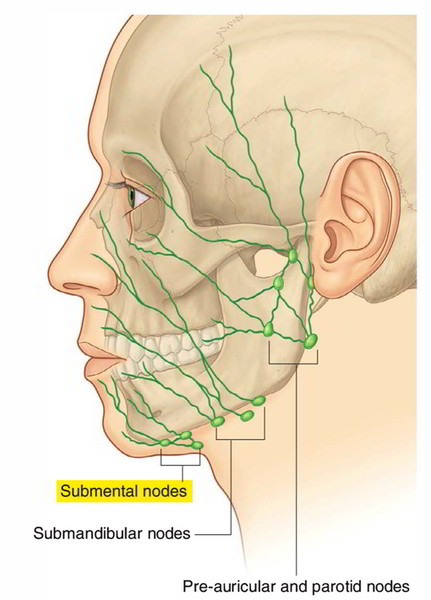The nurse assesses a client's submental lymph nodes. In which area of the client's head should the nurse palpate these lymph nodes?
In front of the ear.
In the midline, a few centimeters behind the tip of the mandible.
Superficial to the sternomastoid.
At the angle of the mandible.
The Correct Answer is B
Choice A reason:
Palpating in front of the ear would assess the preauricular lymph nodes, not the submental lymph nodes. The preauricular nodes are located just in front of the ears and are typically examined when there is an infection or inflammation in the eyes, ears, or scalp.
Choice B reason:
The submental lymph nodes are located in the midline, just under the chin, behind the bony prominence of the mandible. This is the correct area for palpation when assessing the submental lymph nodes. These nodes drain the lower lip, the floor of the mouth, the tip of the tongue, and the incisors, and they can become enlarged due to infections or malignancies in these areas.
Choice C reason:
Palpating superficial to the sternomastoid would assess the cervical lymph nodes, specifically the anterior cervical nodes, which are not the submental lymph nodes. The sternomastoid muscle is a landmark for several lymph node groups in the neck, but not for the submental group.
Choice D reason:
Palpating at the angle of the mandible would assess the submandibular lymph nodes, not the submental lymph nodes. The submandibular nodes are located beneath the jawline and can become enlarged due to infections or malignancies in the mouth, throat, and salivary glands.

Nursing Test Bank
Naxlex Comprehensive Predictor Exams
Related Questions
Correct Answer is B
Explanation
Choice a reason:
Tympany is a drum-like, resonant sound that is typically heard over air-filled structures, such as the gastric bubble, not the chest. It is not a sound associated with the lungs, especially in the context of COPD.
Choice b reason:
Hyperresonance is an abnormally loud, lower-pitched sound than normal resonance heard over hyperinflated areas of the lung, such as in cases of COPD. This is due to the increased air content within the lungs, often because of overdistension or destruction of alveolar tissue, as seen in emphysema, a common type of COPD.
Choice c reason:
Resonance is the normal sound heard over healthy lung tissue when percussed. However, in the case of COPD, particularly emphysema, the destruction of lung tissue leads to hyperinflation and thus a hyperresonant sound rather than the normal resonance.
Choice d reason:
Dullness is heard when fluid or solid tissue replaces air in the lung or occupies the pleural space, as in the case of pneumonia or pleural effusion. This is not characteristic of COPD, where there is an increase in air due to the breakdown of alveolar walls.
Correct Answer is A
Explanation
Choice a reason :
Referring the client for medical follow-up is the most appropriate action. Acanthosis Nigricans is often associated with insulin resistance and is a risk factor for diabetes mellitus. The client's symptoms of fatigue, thirst, and frequent urination are classic signs of diabetes. Therefore, a comprehensive medical evaluation is necessary to rule out diabetes or other underlying conditions that could be causing these symptoms.
Choice b reason
While Acanthosis Nigricans can sometimes be associated with malignancy, it is more commonly linked to insulin resistance and diabetes. The client's presenting symptoms are not typical of cancer but are indicative of diabetes. Therefore, while a family history of cancer is relevant to the client's overall health, it is not the immediate concern based on the current presentation.
Choice c reason
Documenting findings is an essential part of the nursing process; however, the presence of Acanthosis Nigricans, especially when coupled with symptoms of fatigue, thirst, and frequent urination, should not be considered benign without further investigation. These findings warrant further assessment to determine the underlying cause.
Choice d reason
Performing a random blood sugar test could be a part of the initial assessment; however, it should not replace a referral for a comprehensive medical evaluation. A random blood sugar test alone may not be sufficient to diagnose diabetes or determine the cause of the client's symptoms. A full medical follow-up will likely include blood sugar testing along with other diagnostic tests.
Whether you are a student looking to ace your exams or a practicing nurse seeking to enhance your expertise , our nursing education contents will empower you with the confidence and competence to make a difference in the lives of patients and become a respected leader in the healthcare field.
Visit Naxlex, invest in your future and unlock endless possibilities with our unparalleled nursing education contents today
Report Wrong Answer on the Current Question
Do you disagree with the answer? If yes, what is your expected answer? Explain.
Kindly be descriptive with the issue you are facing.
